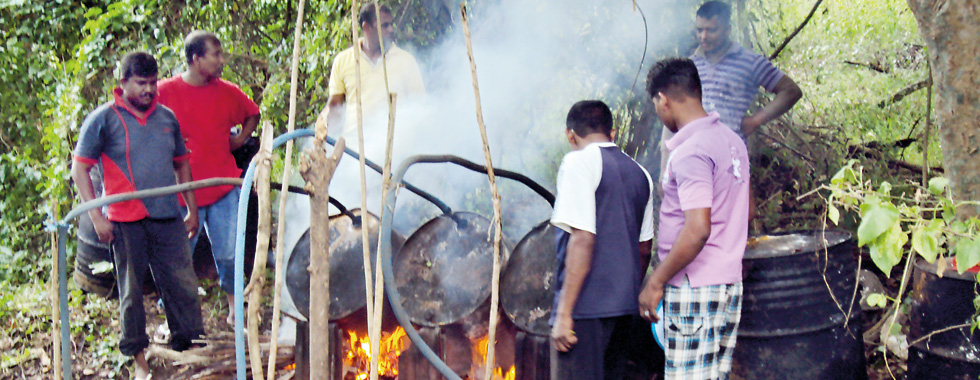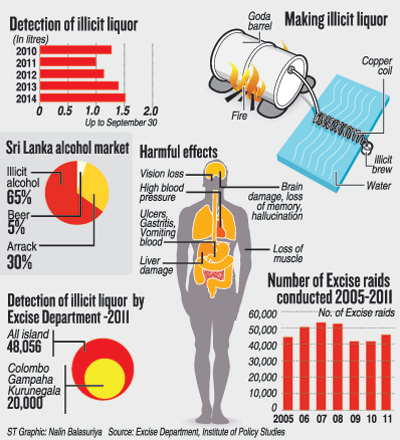News
Kasippu use rising but Excise says moonshine
 With rising costs putting hard liquor beyond their reach, many drinkers are turning in large numbers to kasippu, brewed by about 5,000 producers nationwide and estimated to comprise about 60 per cent of the total alcohol market. Police have arrested nearly 70,000 people and seized more than 1.5 million litres of illicit brew in raids on producers and outlets so far this year.
With rising costs putting hard liquor beyond their reach, many drinkers are turning in large numbers to kasippu, brewed by about 5,000 producers nationwide and estimated to comprise about 60 per cent of the total alcohol market. Police have arrested nearly 70,000 people and seized more than 1.5 million litres of illicit brew in raids on producers and outlets so far this year.
Consumption of kasippu, considered the poor man’s drink, is thriving as locally-produced licit alcohol is slapped with more and more taxes, driving up its price. An estimated 60 per cent of the alcohol market is illicit, with only 30 consisting of legal hard liquor and just 5 per cent beer, says G.D. Dayaratne, Manager of Health Policy Programmes at the Institute of Policy Studies.
That figure is fiercely contested by the Excise Department, which says its raids on moonshine makers have reduced production. Mr. Dayaratne, citing a study conducted by IPS last year, said people with lower incomes were buying kasippu and forgoing licensed liquor selling at wholesale prices of Rs. 600 and retail prices of Rs. 1,000.
 On November 13, police raids resulted in the arrest of nine people and the confiscation of 14 barrels of “goda” (a raw material used in kasippu), and two large containers and production of 336 bottles of kasippu amounting to 2,688 drams from a site in Wennappuwa. Just four days later, alcohol and illicit liquor worth Rs. 150,000 was confiscated from raids in Galagedara, Padukka and Homagama and three persons we arrested.
On November 13, police raids resulted in the arrest of nine people and the confiscation of 14 barrels of “goda” (a raw material used in kasippu), and two large containers and production of 336 bottles of kasippu amounting to 2,688 drams from a site in Wennappuwa. Just four days later, alcohol and illicit liquor worth Rs. 150,000 was confiscated from raids in Galagedara, Padukka and Homagama and three persons we arrested.
This year alone, police have confiscated 1,511,513 litres of illicit alcohol and arrested 67,497 people in connection with the moonshine trade. While the quantity of alcohol confiscated has increased by almost 10 per cent the number of arrests has decreased by close on 20 per cent from last year, a trend that continues from previous years.
The numbers also highlight a steady increase in production per producer. The Excise Department, however, claims that the production of illicit alcohol has dropped.
“The quantities have increased as the police have intensified their raids and now attack the production places not just consumers or middle-men,” said Prabath Jayawickrema, Superintendent of Excise and media spokesperson of the department.
A belt of illicit production runs along the Negombo coastline to Wennappuwa, Kirindiwela , Seeduwa and Ja-Ela, Mr. Dayaratne said. “Other major production occurs in areas around Avissawella and Maharagma. A major portion of this production comes to Colombo market.” Mr. Dayaratne said there are estimated to be more than 200,000 illicit alcohol outlets operating in the country and about 5,000 manufacturers.
Apart from activity in Colombo and Gampaha, which has the highest production and consumption, villagers produce illicit alcohol for their local markets. “There is a major sub-network of suppliers selling rotten fruit as raw material to the kasippu producers,” Mr. Dayaratne said. Many operate from Pettah’s Manning Market, where all the rotten fruit is collected daily and sold to producers.
Ethanol, imported for the production of licensed alcohol based products, also ends up in illicit production, Mr. Dayaratne said. The per capita consumption of alcohol in the country is 12 litres, which is higher than the international average of 10 litres. A new trend observed through the research is that post-war communities in the north and east are fast becoming big consumers. Of these, Trincomalee, Batticaloa and Mullaitivu are topping the charts with 11 litres of per capita consumption of alcohol.
Although the country has observed a decrease in youth consumption, the situation in the north and east is different, Mr. Dayaratne said. “An increasing number of females in the North and the East are engaged in production of illicit alcohol, and more and more youth are getting into the habit of drinking,” he said. Since illicit alcohol production does not happen in a monitored environment methanol, a lethal substance, is present in the brew in varying proportions.
Methanol can cause serious sight problems ranging from blindness to reduced visual acuity , damaged optical disc, retinal oedema and blurred vision. Medical practitioners warn against the consumption of illicit alcohol because of such problems. Methanol can also result in confusion, depression and drowsiness which are also observed in alcohol overdose cases as well.
The severity of the affects will depend on the dose, explained Dr. Kirthi Withanage, a medical officer attached to the National Hospital’s Poisons Department. “We have had cases where 10 to 15 people suddenly went blind or experienced these health issues after drinking from a batch of kasippu with a high concentration of methanol. There have been several such incidents over the years,” Dr. Withanage said.
“The continued intake of small doses can also lead to similar health issues”.

